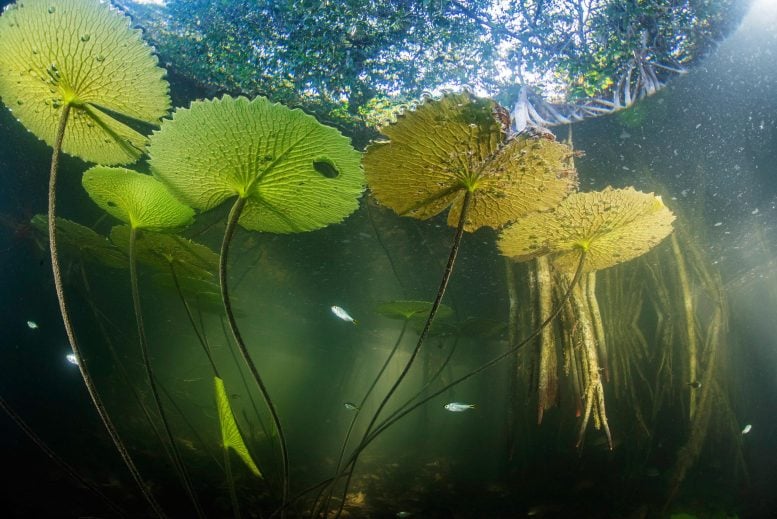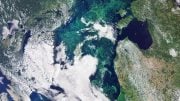
The aquatic life of the San Pedro Mártir River in Tabasco, Mexico, finds refuge in the submerged roots of the red mangrove forests. Credit: Octavio Aburto
Researchers investigate an ancient coastal ecosystem found more than 120 miles from the nearest ocean, revealing sea level impacts from the last interglacial period.
Deep in the heart of the Yucatan Peninsula, an ancient mangrove ecosystem flourishes more than 200 kilometers (124 miles) from the nearest ocean. This is unusual because mangroves—salt-tolerant trees, shrubs, and palms—are typically found along tropical and subtropical coastlines.
A new study led by researchers across the University of California system in the United States and researchers in Mexico focuses on this luxuriant red mangrove forest. This “lost world” is located far from the coast along the banks of the San Pedro Martir River, which runs from the El Petén rainforests in Guatemala to the Balancán region in Tabasco, Mexico.
Because the red mangrove (Rhizophora mangle) and other species present in this unique ecosystem are only known to grow in salt water or somewhat salty water, the binational team set out to discover how the coastal mangroves were established so deep inland in fresh water completely isolated from the ocean. Their findings were published today (October 4, 2021) in the Proceedings of the National Academy of Sciences of the United States of America.
Integrating genetic, geologic, and vegetation data with sea-level modeling, the study provides a first glimpse of an ancient coastal ecosystem. The researchers found that the San Pedro mangrove forests reached their current location during the last interglacial period, some 125,000 years ago, and have persisted there in isolation as the oceans receded during the last glaciation.
The study provides a snapshot of the global environment during the last interglacial period, when the Earth became very warm and polar ice caps melted entirely, making global sea levels much higher than they are today.
“The most amazing part of this study is that we were able to examine a mangrove ecosystem that has been trapped in time for more than 100,000 years,” said study co-author Octavio Aburto-Oropeza, a marine ecologist at Scripps Institution of Oceanography at UC San Diego and a PEW Marine Fellow. “There is certainly more to discover about how the many species in this ecosystem adapted throughout different environmental conditions over the past 100,000 years. Studying these past adaptations will be very important for us to better understand future conditions in a changing climate.”
Combining multiple lines of evidence, the study demonstrates that the rare and unique mangrove ecosystem of the San Pedro River is a relict—that is, organisms that have survived from an earlier period—from a past warmer world when relative sea levels were six to nine meters (20 to 30 feet) higher than at present, high enough to flood the Tabasco lowlands of Mexico and reach what today are tropical rainforests on the banks of the San Pedro River.
The study highlights the extensive landscape impacts of past climate change on the world’s coastlines and shows that during the last interglacial, much of the Gulf of Mexico coastal lowlands were under water. Aside from providing an important glimpse of the past and revealing the changes suffered by the Mexican tropics during the ice ages, these findings also open opportunities to better understand future scenarios of relative sea-level rise as climate change progresses in a human-dominated world.
Carlos Burelo, a botanist at the Universidad Juárez Autónoma de Tabasco and a native of the region, drew the attention of the rest of the team towards the existence of this relict ecosystem in 2016. “I used to fish here and play on these mangroves as a kid, but we never knew precisely how they got there,” said Burelo. “That was the driving question that brought the team together.”
Burelo’s field work and biodiversity surveys in the region established the solid foundation of the study. His remarkable discovery of the ancient ecosystem is documented in “Memories of the Future: the modern discovery of a relict ecosystem,” an award-winning short film produced by Scripps alumnus Ben Fiscella Meissner (MAS MBC ‘17).
Felipe Zapata and Claudia Henriquez of UCLA led the genetic work to estimate the origin and age of the relict forest. Sequencing segments of the genomes of the red mangrove trees, they were able to establish that this ecosystem migrated from the coasts of the Gulf of Mexico into the San Pedro River over 100,000 years ago and stayed there in isolation after the ocean receded when temperatures dropped. While mangroves are the most notable species in the forest, they found nearly 100 other smaller species that also have a lineage from the ocean.
“This discovery is extraordinary,” said Zapata. “Not only are the red mangroves here with their origins printed in their DNA, but the whole coastal lagoon ecosystem of the last interglacial has found refuge here.”
Paula Ezcurra, science program manager at the Climate Science Alliance, carried out the sea-level modeling, noting that the coastal plains of the southern Gulf of Mexico lie so low that a relatively small change in sea level can produce dramatic effects inland. She said a fascinating piece of this study is how it highlights the benefits of working collaboratively among scientists from different disciplines.
“Each piece of the story alone is not sufficient, but when taken together, the genetics, geology, botany, and field observations tell an incredible story. Each researcher involved lent their expertise that allowed us to uncover the mystery of a 100,000+ year-old forest,” said Ezcurra, an alumna of Scripps Oceanography (MAS CSP ‘17).
The field work was led by the ecologists on the team—Octavio Aburto-Oropeza, Paula Ezcurra, Exequiel Ezcurra of UC Riverside, and Sula Vanderplank of Pronatura Noroeste. Visiting the study sites several times starting in 2016, they collected rocks, sediments and fossils to analyze in the lab, helping them pinpoint evidence from the past that is consistent with a marine environment.
The authors note that the region surrounding the study sites was systematically deforested in the 1970s by a misguided development plan; the banks of the San Pedro River were only spared because the bulldozers could not reach it. The area is still threatened by human activities, so the researchers stressed the need to protect this biologically important area in the future.
“We hope our results convince the government of Tabasco and Mexico’s environmental administration of the need to protect this ecosystem,” they said. “The story of Pleistocene glacial cycles is written in the DNA of its plants waiting for scientists to decipher it but, more importantly, the San Pedro mangroves are warning us about the dramatic impact that climate change could have on the coastal plains of the Gulf of Mexico if we do not take urgent action to stop the emission of greenhouse gases.”
Reference: “Relict inland mangrove ecosystem reveals Last Interglacial sea levels” by Octavio Aburto-Oropeza, Carlos Manuel Burelo-Ramos, Exequiel Ezcurra, Paula Ezcurra, Claudia L. Henriquez, Sula E. Vanderplank and Felipe Zapata, 4 October 2021, Proceedings of the National Academy of Sciences.
DOI: 10.1073/pnas.2024518118
Funding was provided by the David and Lucile Packard Foundation, the Baum Foundation, the National Geographic Society, and a donation by Gina Rogers.









Be the first to comment on "Hidden Mangrove Forest Deep in the Heart of the Yucatan Peninsula Reveals Ancient Sea Levels"